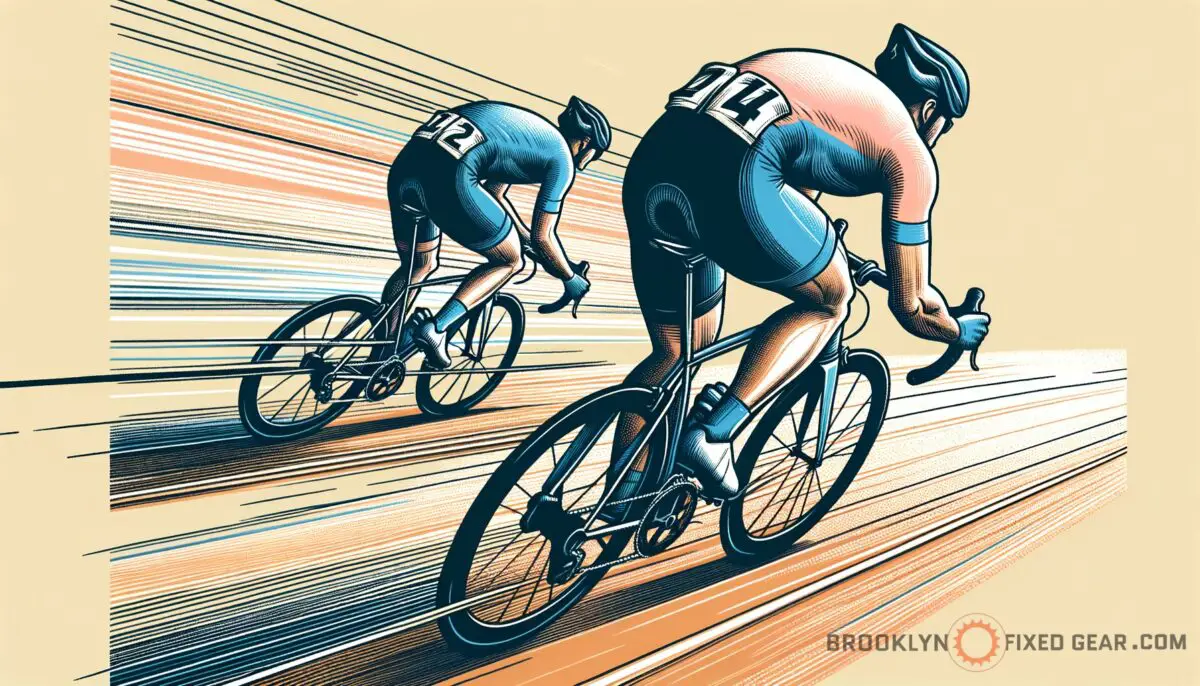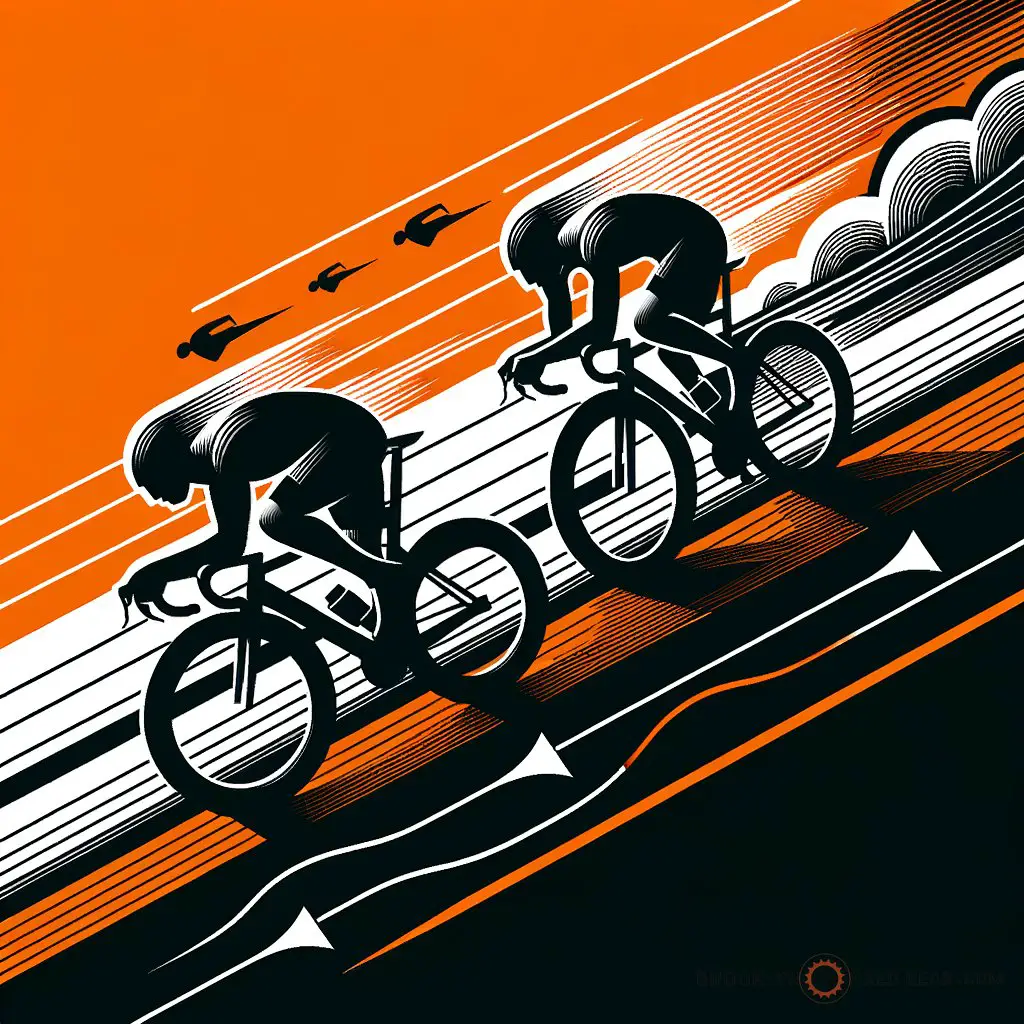Ever wondered how cyclists seem to glide effortlessly in groups during a race? They’re probably drafting, a smart technique for saving energy. Discover how drafting gives riders that strategic edge.
Check out some of the best fixie bikes that embody aerodynamic design.
Key takeaways
- Drafting reduces wind resistance, allowing cyclists to save energy.
- Proper positioning and communication are essential for safe and effective drafting.
- Advanced drafting techniques like echelons can significantly impact race outcomes.
What is drafting in the context of cycling
Drafting, also known as slipstreaming, is a clever trick cyclists use to conserve energy. It involves riding closely behind another cyclist to reduce wind resistance. It’s all about physics – the lead rider battles against the air flow, creating a low-pressure zone behind them.

Here’s how it works:
- Lead Rider: Pushes through the air, working harder, and creates a slipstream.
- Following Rider: Stays in the slipstream, enjoys less air resistance, and conserves energy.
Sticking close to the wheel in front of you can reduce the energy you use by up to 30%. It’s a game-changer in races where stamina and smart energy use can lead to a win. Drafting isn’t just a racing tactic – even on a casual group ride, tucking in behind a fellow cyclist can help you maintain speed without burning out.
Curious about optimizing your pedal power? Dive into the concept of a dead spot in the context of cycling.
Opinion time: Drafting, my pedal-pushing pals, is pretty neat when you think about it – pure strategy and science on wheels. It’s like catching a breather while your mate faces the headwind. Now, I won’t say I’m an expert on the Tour de France, but there’s this scene I can’t shake from “Breaking Away” – a classic bike race moment where drafting turns the underdog into a champ.
That just shows how a simple trick can rev up your cycling game. But remember, always keep safety in check when you’re riding wheel to wheel out there! Speaking of staying safe while enjoying the ride, check out the essential best bike multi-tools for on-the-go adjustments.
State Bicycle Co. Black Label 6061

State Bicycle Co. Black Label 6061
The essentials of drafting in cycling
Why do cyclists draft?
Drafting is an energy-saving technique used by cyclists to reduce wind resistance. When a cyclist rides behind another, they expend less effort and energy to maintain the same speed. This is because the rider in front is ‘breaking’ the wind, which in turn provides a slipstream for the following rider.

It’s widely used in competitive cycling but also among casual group riders for efficiency. Drafting can save up to 30% of a rider’s energy, making it a crucial strategy for long rides.
How does drafting work?
The effectiveness of drafting hinges on the principle of aerodynamics. By staying close behind the lead cyclist, the following cyclist benefits from reduced air resistance. The size of the drafting effect can vary based on factors such as the size of the lead rider, wind conditions, and the distance between riders.
For greater insight into the mechanics of bikes and how they’re impacted by aerodynamics, take a look at what are deep v’s in the context of cycling.
Positioning and safety while drafting
Proper positioning when drafting
Precision in positioning is vital for successful drafting. Ideal spacing involves staying as close as possible to the leading bike’s rear wheel – usually just a few inches. However, it requires a high level of concentration and bike handling skills, as the margin for error is small.
Any sudden brakes or turns from the leader can result in a collision if the following cyclist responds too slowly.
Safety considerations
While drafting is beneficial, safety should never be compromised. Essential visual cues and communication within the group can maintain safety during drafting. Both the leader and the follower must be aware of road conditions and signals accurately to avoid accidents.
For anyone new to group riding or drafting, practice sessions in less crowded or controlled environments can be very helpful.
Advanced drafting techniques
Echelon formation and crosswinds
An echelon is a staggered, diagonal line of cyclists used to combat crosswinds. If the wind comes from the side, riders adjust their position slightly to the side of the cyclist in front, forming an echelon across the road. This requires excellent coordination and communication as the formation can block traffic and is typically restricted to professional races or closed roads.
Rotating pacelines
In a rotating paceline, each rider takes turns at the front before peeling off and moving to the back of the line. This keeps the work distributed evenly among the group and ensures that no one rider is over-exerted by being at the front for too long. It’s an advanced technique that demands consistent pacing and teamwork.
More tips for efficient drafting

Communicating in the peloton
Clear communication is the backbone of effective drafting and a harmonious peloton. Whether it’s hand signals, vocal cues, or pre-agreed gestures, the group needs to stay in sync to navigate the roads safely.
Training to draft
Drafting is a learned skill, and practice is essential. Training rides with a focus on drafting can help cyclists become more comfortable with the close proximities and split-second decisions required. It’s as much about learning to read the road and the riders as it is about physical conditioning.
Summary of drafting benefits table
This table highlights key benefits of drafting and associated energy savings for cyclists. It provides insights into how drafting influences performance and the type of benefits riders can expect.
| Benefit | Energy Saving (%) | Conditions for Maximum Benefit |
|---|---|---|
| Reduced Effort | Up to 30 | Directly behind the lead cyclist |
| Improved Stamina | Variable | Long rides, consistent pacing |
| Increased Speed | Variable | Well-coordinated group, efficient turns |
Drafting in cycling is like a dance on wheels where each move saves a beat of energy for the final showdown. It’s a strategic play of aerodynamics that, when mastered, can turn an average rider into a formidable contender.
Drafting not only conserves energy but also optimizes overall group speed, particularly in racing scenarios.
More drafting tips
Leading a peloton or staying in the slipstream requires skill and trust. Here are some tips to enhance your drafting technique:
- Stay Alert: Keep your focus on the rider ahead and be ready for any sudden changes.
- Maintain a Consistent Gap: Practice keeping a steady distance from the wheel in front of you.
- Learn to Anticipate Moves: Pay attention to the body language and pedaling of the cyclist in front.
- Master Bike Handling: Improve your control over your bike with regular practice.
- Understand Wind Patterns: Learn how different wind conditions affect drafting and adjust accordingly.
- Pace Line Practices: Join a cycling club to get experience with rotating pacelines.
Regarding being part of a cohesive unit on the road, here are some important dos and don’ts:
Dos and don’ts for effective drafting
| Do | Don’t |
|---|---|
| Communicate clearly with hand signals or calls. | Draft too close without sufficient practice. |
| Take short turns at the front if feeling tired. | Make sudden movements that can startle riders behind. |
| Stay relaxed and maintain a light grip on the handlebars. | Overlap wheels, as it increases the risk of crashing. |
| Look through the rider in front to anticipate obstacles. | Focus only on the wheel directly ahead of you. |
Drafting requires coordination and mutual respect among cyclists to create the perfect slipstream and safety bubble.
Advantages and disadvantages of drafting
Drafting is a double-edged sword in cycling, bringing a mix of benefits and challenges to riders.
Advantages
- Energy Efficiency: Reduces the amount of effort to maintain speed.
- Speed Maintenance: Helps maintain a higher average speed without increasing exertion.
- Stamina Conservation: Allows riders to conserve stamina for crucial points like sprints or climbs.
- Team Strategy: It serves as a critical team strategy in competitive cycling.
Disadvantages
- Dependence on the Lead Rider: The follower must trust the lead rider’s ability to navigate dangers.
- Accident Risk: Increased risk of accidents due to close proximity to other riders.
- Less Visibility: Following riders have fewer visuals of the road ahead.
- Limited Maneuverability: Being in a tight formation can limit the ability to maneuver swiftly in response to obstacles.
If you are a visual learner, check out this video titled ‘Where Is The Best Place To Draft When Cycling In A Group? | Ask GCN Anything’
Frequently asked questions (FAQ)
Can drafting be beneficial in headwinds as well as tailwinds?
Absolutely, drafting can be significantly beneficial in both headwinds and tailwinds. In a headwind, the lead cyclist takes the brunt of the resistance, while in a tailwind, the drafting cyclist can use less energy to keep up or even take a breather.
How important is rider size in drafting effectiveness?
Rider size can influence the effectiveness of drafting. A larger lead rider can provide a wider slipstream, making it easier for a following cyclist to draft. However, skill and technique remain critical components for all riders, regardless of size.
Is drafting legal in all bicycle races?
Drafting is legal in most road cycling races; however, it’s prohibited in individual time trials and non-drafting triathlons. Each race has its specific set of rules, so it’s essential to check the regulations beforehand.
Final thoughts
Wrapping up, drafting is not just a savvy racing tactic; it’s a collaborative effort that highlights the beauty of cycling as both an individual and a team sport. Mastering drafting can elevate your riding experience, allowing you to conserve energy and enjoy longer rides with your crew. Remember, while drafting provides benefits, always prioritize safety and communication among your fellow riders.
How has drafting changed the way you ride? Did I cover everything you wanted to know? Let me know in the comments section below.I read and reply to every comment. If you found this article helpful, share it with a friend, and check out my full blog for more tips and tricks on drafting and cycling strategies. Thanks for reading and keep rolling smoothly on your journey!















